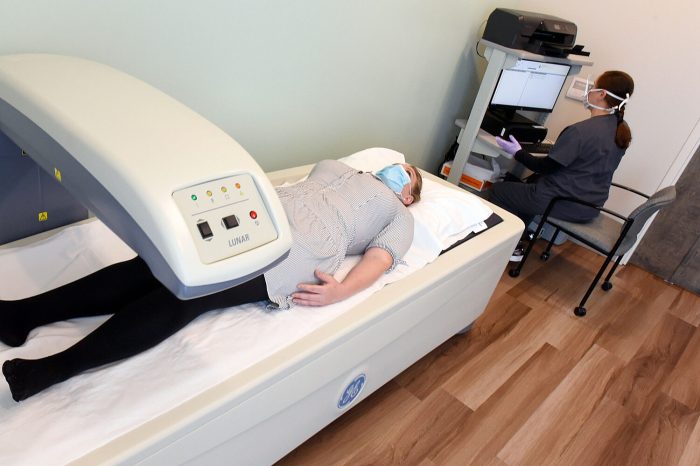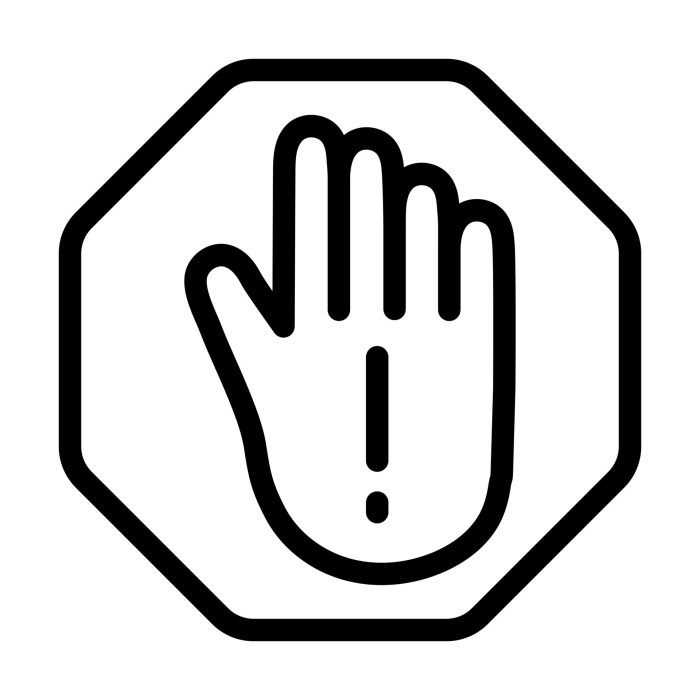How to prevent and manage osteopenia is a crucial topic for maintaining bone health. Osteopenia, a condition characterized by lower bone density than normal, often precedes osteoporosis, making early detection and management vital. This guide delves into the various facets of preventing and managing osteopenia, exploring dietary strategies, lifestyle modifications, medical interventions, and monitoring techniques. We’ll examine the factors contributing to its development, from genetics to lifestyle choices, to provide a complete understanding of this often overlooked health concern.
Understanding the prevalence and impact of osteopenia on public health is essential. This comprehensive guide covers dietary strategies, lifestyle modifications, medical interventions, and monitoring techniques, allowing readers to take proactive steps towards bone health. It will empower individuals to take charge of their bone health, making informed decisions about their diet, exercise, and medical care.
Introduction to Osteopenia
Osteopenia is a condition characterized by lower bone density than normal, but not low enough to be classified as osteoporosis. Essentially, it represents a transitional stage between healthy bone mass and the more serious bone loss associated with osteoporosis. While osteopenia itself might not cause immediate symptoms, it significantly increases the risk of fractures later in life. Understanding the factors that contribute to its development and recognizing the importance of early intervention are crucial for maintaining skeletal health.
Defining Osteopenia and its Distinction from Osteoporosis
Osteopenia is diagnosed when bone mineral density (BMD) falls below the average peak bone density, but not to the extent of osteoporosis. The World Health Organization (WHO) uses bone density measurements to categorize these conditions. A T-score between -1 and -2.5 indicates osteopenia, while a T-score below -2.5 indicates osteoporosis. This distinction is important because while osteopenia increases fracture risk, osteoporosis represents a more advanced stage with a higher fracture risk.
Factors Contributing to Osteopenia Development
Several factors can contribute to the development of osteopenia. Genetics plays a significant role, as individuals with a family history of osteoporosis are more susceptible. Dietary deficiencies in calcium and vitamin D are crucial contributors, as these nutrients are essential for bone health. Lifestyle factors like inadequate physical activity, smoking, excessive alcohol consumption, and certain medications (e.g., corticosteroids) can also negatively impact bone density, potentially leading to osteopenia.
Importance of Early Detection and Management
Early detection of osteopenia is vital for preventive measures and management. Regular bone density screenings, particularly for individuals at higher risk, can help identify the condition early. Early management strategies can help slow or halt the progression of bone loss, thereby reducing the risk of fractures. Dietary adjustments, lifestyle modifications, and potential medication (if prescribed by a physician) can all play a role in managing osteopenia effectively.
Prevalence and Public Health Impact
Osteopenia affects a substantial portion of the population, particularly as individuals age. Studies suggest a high prevalence of osteopenia in postmenopausal women and older adults, highlighting the significant public health impact. This condition can lead to increased healthcare costs associated with fractures and related complications. The impact extends beyond individual well-being, affecting the overall healthcare system’s capacity and resources.
Preventing and managing osteopenia involves a multifaceted approach, including a healthy diet rich in calcium and vitamin D. Supplementing with nutrients like those found in the benefits of royal jelly might also play a role, as some studies suggest it can support bone health. Ultimately, a balanced lifestyle incorporating regular exercise and appropriate medical guidance is crucial for maintaining strong bones and preventing further bone loss.
Understanding Osteopenia Stages
| Stage | Symptoms | Risk Factors | Prevention Strategies |
|---|---|---|---|
| Early Osteopenia | Typically asymptomatic. May include mild back pain or discomfort. | Family history of osteoporosis, low calcium intake, lack of weight-bearing exercise, smoking, excessive alcohol consumption. | Increase calcium and vitamin D intake, engage in regular weight-bearing exercises (e.g., walking, jogging, dancing), quit smoking, limit alcohol consumption. |
| Moderate Osteopenia | May experience more pronounced back pain, reduced height, and increased susceptibility to falls. | Prolonged use of corticosteroids, hormonal imbalances, inadequate sun exposure, low body weight, sedentary lifestyle. | Seek professional medical advice, focus on a balanced diet rich in calcium and vitamin D, engage in regular weight-bearing exercises and strength training, consider medication if prescribed. |
| Severe Osteopenia | Increased risk of fractures with minimal trauma. Significant bone pain. | Advanced age, certain medical conditions (e.g., celiac disease, hyperthyroidism), lack of physical activity, malnutrition. | Close monitoring by healthcare professionals, a highly tailored nutrition plan, targeted physical therapy and rehabilitation, adherence to medication as prescribed. |
Dietary Strategies for Prevention and Management
Nourishing your body with the right foods is crucial in preventing and managing osteopenia. A balanced diet rich in bone-building nutrients can significantly impact bone density and reduce the risk of fractures. Understanding the role of specific nutrients and incorporating them into your daily meals is key to optimal bone health.
Importance of Calcium and Vitamin D
Calcium and vitamin D work synergistically to support bone health. Calcium is the primary building block of bones and teeth, while vitamin D aids in calcium absorption. Adequate intake of both nutrients is essential for maintaining bone density throughout life. Insufficient calcium and vitamin D intake can lead to weaker bones, increasing the risk of fractures, particularly as we age.
High-Calcium Foods and Dietary Recommendations
A varied diet rich in calcium-rich foods is a cornerstone of maintaining strong bones. Milk and dairy products are excellent sources, but many other foods contain calcium.
Taking steps to prevent and manage osteopenia is crucial for long-term bone health. A balanced diet rich in calcium and vitamin D, coupled with regular weight-bearing exercise, is key. Interestingly, while researching the connection between lifestyle choices and bone density, I stumbled upon an intriguing question: is there a link between sneezing and migraines? This article delves into the potential connection, which, while fascinating, doesn’t directly relate to preventing osteopenia.
Ultimately, focusing on those crucial lifestyle factors remains the best approach to building strong bones and managing osteopenia.
- Dairy products (milk, yogurt, cheese): These are excellent sources of calcium and are often fortified with vitamin D. Choose low-fat or non-fat options to minimize saturated fat intake.
- Leafy green vegetables (kale, collard greens, bok choy): These provide calcium and other essential nutrients. Cooking methods can affect calcium absorption, so consider steaming or lightly sautéing these greens.
- Fortified foods (orange juice, cereals, plant-based milks): Many foods are fortified with calcium and vitamin D, providing a convenient way to increase intake.
- Calcium-set tofu: A good source of calcium for those following a plant-based diet. The calcium content varies depending on the specific preparation.
- Sardines and canned salmon with bones: These provide both calcium and vitamin D, as well as other essential nutrients.
Vitamin D-Rich Foods and Supplements
Vitamin D is crucial for calcium absorption. Sunlight exposure is a natural source, but dietary intake is also important.
- Fatty fish (salmon, tuna, mackerel): These are excellent sources of vitamin D and omega-3 fatty acids.
- Egg yolks: A moderate source of vitamin D.
- Fortified foods (some cereals, plant-based milks): Many foods are fortified with vitamin D, offering a convenient way to increase intake.
- Vitamin D supplements: If dietary intake is insufficient, supplements can be beneficial. Consult with a healthcare professional before starting any new supplement regimen.
Comparison of Calcium Supplements, How to prevent and manage osteopenia
Various calcium supplements are available. Choosing the right one depends on individual needs and preferences.
- Calcium carbonate: Often less expensive but requires stomach acid for absorption, making it best taken with meals.
- Calcium citrate: Better absorbed even without stomach acid, making it suitable for those with low stomach acid or who take medications that reduce stomach acid.
- Calcium gluconate: Generally well-absorbed but may be less potent than other forms.
Role of Protein, Magnesium, and Other Micronutrients
Protein, magnesium, and other micronutrients play a vital role in bone health, supporting bone structure and strength. A balanced diet rich in various nutrients is key.
Nutrient Table
| Nutrient | Function | Food Sources | Recommended Intake |
|---|---|---|---|
| Calcium | Essential component of bones and teeth | Dairy products (milk, yogurt, cheese), leafy green vegetables, fortified foods | 1000-1200 mg/day (adults) |
| Vitamin D | Aids in calcium absorption | Fatty fish, egg yolks, fortified foods, sunlight exposure | 600 IU/day (adults) |
| Protein | Supports bone structure and strength | Meat, poultry, fish, beans, lentils, eggs | 0.8 g/kg of body weight/day (adults) |
| Magnesium | Supports bone metabolism and calcium absorption | Leafy green vegetables, nuts, seeds, whole grains | 310-400 mg/day (women), 400-420 mg/day (men) |
Lifestyle Modifications for Prevention and Management
Osteopenia, while not a disease, is a significant risk factor for osteoporosis, a condition characterized by weakened bones. Lifestyle modifications play a crucial role in preventing bone loss and managing osteopenia. These changes, often simple and sustainable, can have a profound impact on bone health and overall well-being.
Impact of Exercise on Bone Density
Regular exercise is essential for maintaining bone density and preventing bone loss. Weight-bearing exercises, in particular, stimulate bone growth and remodeling, making bones stronger and denser. Resistance training also plays a significant role in increasing bone mineral density. The body responds to stress by building stronger bones, similar to how muscles become stronger with resistance training.
Taking steps to prevent and manage osteopenia involves a healthy diet rich in calcium and vitamin D, regular weight-bearing exercise, and avoiding smoking. While dealing with a rash can be frustrating, sometimes a simple topical treatment like calamine lotion for rash calamine lotion for rash can offer relief. Ultimately, focusing on these lifestyle choices is key to maintaining bone health and preventing further complications.
Weight-Bearing Exercises for Bone Health
Weight-bearing exercises involve activities that force the bones to work against gravity. These activities stimulate bone formation and help maintain bone density.
- Walking: A simple and accessible exercise, brisk walking is an excellent way to strengthen bones and improve cardiovascular health.
- Running: A more intense form of weight-bearing exercise, running can significantly impact bone density, but proper form and pacing are essential to prevent injuries.
- Hiking: Hiking on varied terrain provides a good weight-bearing workout, promoting bone health and offering opportunities for fresh air and scenery.
- Dancing: Many dance forms involve weight-bearing movements, making them effective for bone strengthening. Consider ballroom dancing or other rhythmic dance styles.
- Stair Climbing: Climbing stairs is a convenient and effective way to incorporate weight-bearing exercise into daily routines.
Resistance Exercises for Bone Health
Resistance exercises, often performed with weights or resistance bands, build muscle strength and indirectly contribute to bone density.
- Lifting Weights: Using weights of varying resistance challenges the muscles and bones, promoting bone growth and preventing bone loss.
- Bodyweight Exercises: Push-ups, squats, lunges, and planks are examples of bodyweight exercises that provide resistance and stimulate bone density.
- Resistance Band Exercises: Resistance bands provide a convenient and versatile way to perform a variety of resistance exercises, especially suitable for those with limited access to weights or for home workouts.
Maintaining a Healthy Weight
Maintaining a healthy weight is crucial for bone health. Being underweight can increase the risk of bone loss, while being overweight or obese can also put stress on bones and increase the risk of fractures.
A balanced diet and regular exercise are key components of a healthy weight management strategy. Consult with a healthcare professional or registered dietitian for personalized recommendations.
Smoking and Alcohol Consumption
Smoking and excessive alcohol consumption significantly contribute to bone loss. Smoking reduces bone density, while excessive alcohol intake interferes with calcium absorption and bone formation.
“Smoking and heavy alcohol use are major contributors to bone loss and an increased risk of fractures.”
Stress Management Techniques
Chronic stress can negatively impact bone health by increasing the release of hormones that contribute to bone loss. Stress management techniques can help mitigate these effects.
- Mindfulness Meditation: Practicing mindfulness meditation can help reduce stress levels and promote relaxation, positively influencing bone health.
- Yoga: Yoga combines physical postures, breathing techniques, and meditation, promoting relaxation and stress reduction.
- Deep Breathing Exercises: Deep breathing exercises can calm the nervous system and reduce stress responses, potentially benefiting bone health.
- Spending Time in Nature: Spending time outdoors in nature can promote relaxation and reduce stress, potentially contributing to improved bone health.
- Social Connection: Maintaining strong social connections and supportive relationships can act as a buffer against stress and promote overall well-being, including bone health.
Medical Interventions for Osteopenia

Osteopenia, while often manageable through lifestyle and dietary changes, may require medical intervention in some cases. This section explores the medications and other medical approaches used to treat osteopenia, emphasizing the benefits, potential risks, and factors influencing treatment decisions. Understanding these aspects is crucial for making informed choices about your health.
Medications for Osteopenia
Various medications can help manage and potentially reverse osteopenia. Their effectiveness and appropriateness depend on individual circumstances and the severity of the condition. A healthcare professional will assess your specific needs before recommending any medication.
Bisphosphonates
Bisphosphonates are a common class of medication used to treat osteopenia and osteoporosis. They work by inhibiting the breakdown of bone tissue, thereby encouraging bone growth and density.
- Mechanism of Action: Bisphosphonates bind to bone mineral and inhibit the activity of osteoclasts, the cells responsible for bone resorption. This reduces bone turnover and allows for increased bone density.
- Benefits: Bisphosphonates can effectively increase bone mineral density, reducing the risk of fractures. They are generally well-tolerated and available in various forms.
- Potential Side Effects: Common side effects include gastrointestinal issues such as heartburn, nausea, and abdominal pain. More serious, though less common, side effects can include osteonecrosis of the jaw (ONJ) and atypical femoral fractures. The risk of these side effects is often influenced by factors such as dosage, duration of use, and overall health.
Hormone Therapy
Hormone therapy, often estrogen replacement therapy, plays a role in bone health, particularly for women after menopause. Estrogen is crucial for maintaining bone density, and its decline after menopause can contribute to bone loss.
- Mechanism of Action: Estrogen helps maintain bone density by inhibiting bone resorption and stimulating bone formation. It also helps regulate calcium absorption.
- Benefits: Estrogen therapy can effectively slow or reverse bone loss, improving bone density and reducing the risk of fractures. It can also help alleviate menopausal symptoms.
- Potential Side Effects: Potential side effects include an increased risk of blood clots, stroke, and breast cancer. The risks and benefits of hormone therapy must be carefully considered on a case-by-case basis.
Other Medical Interventions
Beyond medications, other medical interventions may be considered, depending on the individual’s needs and the underlying causes of osteopenia.
- Calcium and Vitamin D Supplements: These are often recommended in conjunction with other treatments to ensure adequate calcium and vitamin D intake. Calcium is crucial for bone health, and vitamin D helps the body absorb calcium.
- Parathyroid Hormone (PTH) Analogs: These medications stimulate bone formation. They are typically used for more severe cases of osteopenia or osteoporosis.
- Calcitonin: This hormone can slow bone loss, but it’s less commonly used than other treatments due to potential side effects.
Medication Comparison Table
| Medication | Mechanism of Action | Benefits | Potential Side Effects |
|---|---|---|---|
| Bisphosphonates (e.g., Alendronate) | Inhibit osteoclast activity, reducing bone resorption. | Increased bone density, reduced fracture risk. | Gastrointestinal issues (heartburn, nausea), osteonecrosis of the jaw (ONJ), atypical femoral fractures. |
| Estrogen Replacement Therapy | Maintains bone density by inhibiting bone resorption. | Improved bone density, reduced fracture risk, alleviation of menopausal symptoms. | Increased risk of blood clots, stroke, breast cancer. |
| Parathyroid Hormone (PTH) Analogs (e.g., Teriparatide) | Stimulates bone formation. | Increased bone formation, potentially more rapid bone density improvement. | Potential for hypercalcemia, nausea, leg cramps. |
Monitoring and Evaluation
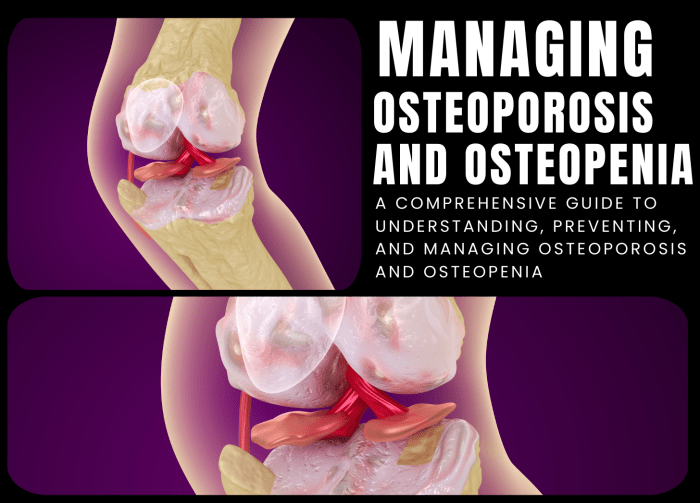
Staying on top of osteopenia requires proactive monitoring and evaluation. Regular assessments help track progress and adjust strategies as needed. This proactive approach allows for timely intervention and helps maintain bone health, potentially preventing the progression to osteoporosis.
Importance of Regular Bone Density Scans
Bone density scans, or DEXA scans, are crucial tools for monitoring osteopenia. They provide a quantitative measure of bone mineral density (BMD), allowing for the detection of changes over time. These scans are particularly vital in identifying whether interventions are effective in improving bone density. Regular scans enable clinicians to adjust treatment plans based on individual responses.
Frequency and Interpretation of Bone Density Test Results
The frequency of bone density scans is determined by individual risk factors and the severity of osteopenia. For individuals with moderate to severe osteopenia, scans may be performed annually or every two years. Those with milder cases might have scans every two to three years. Interpreting the results involves examining the T-score and Z-score.
Interpretation of T-score and Z-score
The T-score compares an individual’s bone density to the average bone density of a healthy young adult of the same sex. A T-score between -1.0 and -2.5 indicates osteopenia. The Z-score, on the other hand, compares bone density to the average bone density of people in the same age group, sex, and ethnicity. A low Z-score might suggest an underlying condition or inadequate calcium intake.
Role of Other Diagnostic Tests
While DEXA scans are the primary diagnostic tool for bone density, other tests can provide additional insights. These include blood tests to assess vitamin D levels, calcium, and parathyroid hormone (PTH). These tests help determine if other factors are contributing to bone loss. For instance, if vitamin D levels are low, supplementation can be recommended.
Monitoring the Effectiveness of Interventions
Monitoring the effectiveness of interventions involves regularly reviewing bone density scan results. Improvements in T-scores, along with improvements in lifestyle factors, such as diet and exercise, indicate that the interventions are working. If no improvement is seen, the healthcare provider might adjust the treatment plan or explore other underlying causes.
Diagnostic Methods for Osteopenia Monitoring
- DEXA Scan (Dual-energy X-ray absorptiometry): This is the gold standard for assessing bone mineral density. The procedure involves lying on a table while an X-ray machine passes over the body. Interpretation involves comparing the patient’s BMD to the average BMD of a healthy young adult of the same sex, producing a T-score. A T-score between -1.0 and -2.5 indicates osteopenia.
Expected outcome: Detection of bone density changes over time, guiding treatment adjustments.
- Blood Tests: Blood tests can assess vitamin D, calcium, and parathyroid hormone (PTH) levels. This procedure involves drawing a blood sample. Interpretation involves evaluating the levels of these markers. Low vitamin D levels might indicate a need for supplementation. Expected outcome: Identification of potential underlying factors contributing to bone loss.
- Urine Tests: Urine tests can measure markers of bone turnover, helping assess the rate of bone resorption and formation. This procedure involves collecting a urine sample. Interpretation involves assessing the levels of bone resorption markers. High markers might suggest increased bone loss. Expected outcome: Understanding the dynamics of bone turnover to fine-tune treatment.
Summary Table of Diagnostic Methods
| Diagnostic Method | Procedure | Interpretation | Expected Outcome |
|---|---|---|---|
| DEXA Scan | Lying on a table while an X-ray machine scans the body | Comparing patient’s BMD to a healthy young adult’s BMD; resulting in a T-score | Identifying bone density changes and adjusting treatment plans |
| Blood Tests | Drawing a blood sample | Evaluating vitamin D, calcium, and PTH levels | Identifying potential underlying factors like vitamin D deficiency |
| Urine Tests | Collecting a urine sample | Assessing bone resorption and formation markers | Understanding bone turnover dynamics to refine treatment strategies |
Prevention Strategies for Specific Populations: How To Prevent And Manage Osteopenia
Osteopenia prevention isn’t a one-size-fits-all approach. Different populations face varying degrees of risk, influenced by factors like age, genetics, and underlying medical conditions. Tailoring strategies to these specific needs is crucial for maximizing effectiveness. This section will delve into targeted prevention methods for high-risk groups.
Postmenopausal Women
Postmenopausal women are at increased risk of osteopenia due to hormonal changes. Estrogen deficiency plays a significant role in bone loss. Strategies to mitigate this risk encompass lifestyle modifications and potential medical interventions. A balanced diet rich in calcium and vitamin D, coupled with regular weight-bearing exercise, is fundamental. Hormone replacement therapy (HRT) might be considered in some cases, but it’s crucial to discuss the potential benefits and risks with a healthcare provider.
Medication options like bisphosphonates, depending on individual factors, could be part of a comprehensive strategy.
Individuals with Certain Medical Conditions
Several medical conditions can negatively impact bone health, increasing the risk of osteopenia. Conditions like celiac disease, inflammatory bowel disease, and hyperthyroidism can interfere with nutrient absorption and bone metabolism. A proactive approach is vital in these situations. Working closely with healthcare professionals is essential to identify and address the underlying medical condition and to create a tailored prevention plan that includes dietary adjustments, potential medications, and regular monitoring.
For example, individuals with inflammatory bowel disease might require specific dietary supplements and medications to manage nutrient deficiencies and maintain bone health.
Role of Genetics in Susceptibility
Genetic predisposition significantly influences an individual’s susceptibility to osteopenia. Family history of osteoporosis is a strong indicator of potential risk. While genetics can’t be altered, understanding this factor empowers individuals to proactively implement preventive measures, particularly those with a family history of the condition.
Prevention Strategies for Individuals with a Family History of Osteoporosis
Individuals with a family history of osteoporosis benefit from early and aggressive preventive measures. This involves a holistic approach that encompasses dietary strategies, lifestyle modifications, and, in some cases, medical interventions. A diet rich in calcium and vitamin D, regular weight-bearing exercise, and smoking cessation are key elements. Early screening and monitoring can help detect any signs of bone loss and allow for timely interventions.
Genetic counseling can also play a role in understanding individual risk and developing tailored prevention plans.
Prevention Strategies for Individuals with Certain Medical Conditions
Prevention strategies for individuals with specific medical conditions require careful consideration of the interplay between the underlying condition and bone health. For example, individuals with celiac disease might need to strictly follow a gluten-free diet to prevent nutrient malabsorption, which can impact bone density. Individuals with hyperthyroidism need to manage their thyroid hormone levels effectively to maintain healthy bone metabolism.
Consultations with endocrinologists and registered dietitians are crucial in developing individualized strategies.
Table: Prevention Strategies for Specific Populations
| Population Group | Risk Factors | Prevention Strategies | Key Considerations |
|---|---|---|---|
| Postmenopausal Women | Estrogen deficiency, decreased bone density, age | Increased calcium and vitamin D intake, weight-bearing exercises, potential hormone replacement therapy (HRT), medication (bisphosphonates) | Individualized assessment of HRT risks, regular bone density screenings |
| Individuals with Celiac Disease | Nutrient malabsorption, decreased calcium and vitamin D levels | Gluten-free diet, calcium and vitamin D supplements, regular bone density screenings | Close monitoring with gastroenterologist and dietitian |
| Individuals with Hyperthyroidism | Increased bone turnover, potential calcium loss | Effective thyroid hormone management, calcium and vitamin D supplementation, regular bone density screenings | Close monitoring with endocrinologist |
| Individuals with Family History of Osteoporosis | Genetic predisposition to low bone density | High calcium and vitamin D intake, weight-bearing exercises, smoking cessation, regular bone density screenings, early intervention | Genetic counseling may be beneficial to understand risk |
Illustrative Examples of Osteopenia
Osteopenia, a condition characterized by low bone mineral density, often progresses silently until it leads to more serious issues like osteoporosis. Understanding the practical aspects of prevention and management is crucial. This section provides real-world examples to illustrate the importance of early detection and proactive measures.The following examples showcase the diverse strategies that can be employed to effectively manage and prevent osteopenia.
These approaches highlight the significance of a holistic approach, integrating diet, exercise, stress reduction, and early intervention.
Healthy Diet Plan for Preventing and Managing Osteopenia
A healthy diet rich in calcium, vitamin D, and other bone-supporting nutrients is fundamental to maintaining optimal bone health. This dietary plan emphasizes nutrient-dense foods and portion control.
- Breakfast (Example): Oatmeal with berries, a sprinkle of chia seeds, and a glass of milk. This provides complex carbohydrates for sustained energy, antioxidants, and calcium from the milk.
- Lunch (Example): A salad with grilled chicken or fish, leafy greens, and a light vinaigrette dressing. Leafy greens are excellent sources of vitamins and minerals, and protein from chicken or fish supports overall health and bone density.
- Dinner (Example): Baked salmon with roasted vegetables like broccoli and carrots. Salmon is a great source of vitamin D and omega-3 fatty acids, while vegetables provide essential vitamins and minerals.
- Snacks (Examples): Hard-boiled eggs, yogurt with fruit, or a handful of almonds. These provide protein, calcium, and healthy fats.
Sample Weekly Exercise Program for Building Bone Density
Regular weight-bearing and resistance exercises are vital for stimulating bone growth and preventing bone loss. This sample program focuses on exercises that specifically target bone density.
- Monday: Walking (30-45 minutes) and light weight training (using dumbbells or resistance bands). Weight-bearing activities stimulate bone formation.
- Tuesday: Yoga (focus on poses that strengthen core muscles and improve balance). Balance exercises are important to reduce the risk of falls.
- Wednesday: Swimming (30-45 minutes). Swimming is a low-impact exercise that is gentle on the joints while providing cardiovascular benefits.
- Thursday: Hiking (1-2 hours) or brisk walking. Hiking provides both weight-bearing exercise and a change of scenery.
- Friday: Strength training (using bodyweight exercises like squats, lunges, push-ups). Strength training is essential for building muscle mass, which helps support bones.
- Saturday & Sunday: Rest or low-impact activities like cycling or gentle stretching. Rest days are crucial for allowing muscles and bones to recover.
Stress-Reduction Plan for Promoting Bone Health
Chronic stress can negatively impact bone health. This plan emphasizes strategies for managing stress and promoting relaxation.
- Mindfulness and Meditation: Practicing mindfulness and meditation techniques can help reduce stress hormones and promote a sense of calm. Even a few minutes of daily meditation can significantly impact stress levels.
- Yoga and Tai Chi: These practices combine physical postures with breathing techniques, promoting relaxation and reducing stress.
- Sufficient Sleep: Adequate sleep is essential for overall health and bone repair. Aim for 7-9 hours of quality sleep each night.
- Spending Time in Nature: Exposure to nature can have a calming effect, reducing stress levels and promoting overall well-being.
Illustrative Scenarios Showcasing Early Detection and Management
Early detection and management of osteopenia are crucial for preventing progression to osteoporosis. A patient with a family history of osteoporosis, experiencing frequent back pain, and having low bone density on a DEXA scan should consider early intervention.
- Scenario 1: A 45-year-old woman experiencing back pain and noticing a decrease in height. A DEXA scan reveals osteopenia. She can start a tailored exercise plan, improve her diet, and reduce stress. This early intervention can prevent further bone loss.
- Scenario 2: A 65-year-old man with a history of low calcium intake. A DEXA scan reveals osteopenia. He can be advised to increase his calcium intake, take vitamin D supplements, and engage in weight-bearing exercises.
Real-World Case Studies Highlighting Positive Outcomes
Numerous case studies demonstrate the effectiveness of preventive measures.
- Case Study 1: A patient diagnosed with osteopenia, following a personalized exercise and dietary plan, experienced a significant increase in bone density within 6 months. This highlights the effectiveness of early intervention.
- Case Study 2: A patient diagnosed with osteopenia implemented a stress reduction plan involving mindfulness meditation. This led to a decrease in stress hormones and improvements in bone density, showcasing the positive impact of holistic strategies.
Importance of a Holistic Approach
Managing osteopenia effectively requires a comprehensive approach that addresses multiple factors. A holistic approach combines diet, exercise, stress management, and medical interventions, to optimize bone health and prevent further bone loss.
Closing Notes
In conclusion, managing and preventing osteopenia requires a multifaceted approach. A balanced diet rich in calcium and vitamin D, regular weight-bearing exercise, and a healthy lifestyle are fundamental to building and maintaining strong bones. While medical interventions may be necessary in certain cases, adopting preventative measures early on can significantly reduce the risk of developing more severe conditions like osteoporosis.
This guide has provided a roadmap for understanding and addressing osteopenia, empowering individuals to make informed decisions about their bone health.

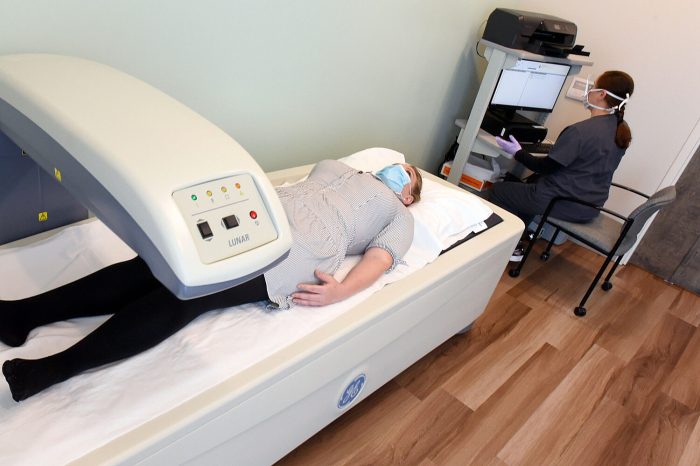
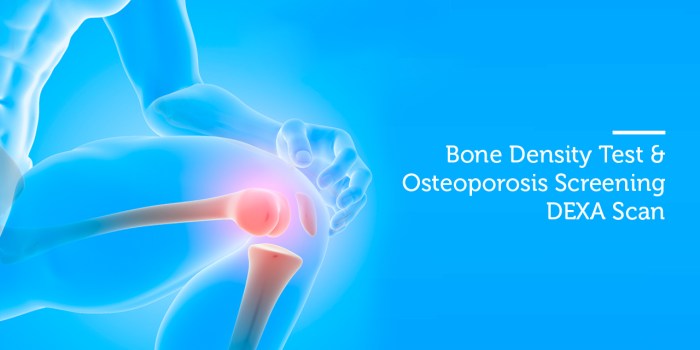
 Description: The flowchart depicts the DEXA scan process from scheduling to result interpretation. Key steps include scheduling the appointment, patient preparation, scan procedure, data analysis, and finally, result interpretation by a healthcare professional. Each step is connected to the next, creating a clear path for the DEXA scan journey.
Description: The flowchart depicts the DEXA scan process from scheduling to result interpretation. Key steps include scheduling the appointment, patient preparation, scan procedure, data analysis, and finally, result interpretation by a healthcare professional. Each step is connected to the next, creating a clear path for the DEXA scan journey. Description: The infographic displays a human body Artikel with highlighted areas specifically measured by the DEXA scan. This includes the spine, hips, and other skeletal regions. Color-coding or shading can be used to emphasize these areas. The diagram should clearly show the different anatomical locations scanned to provide a clear visual representation of the DEXA scan’s function.
Description: The infographic displays a human body Artikel with highlighted areas specifically measured by the DEXA scan. This includes the spine, hips, and other skeletal regions. Color-coding or shading can be used to emphasize these areas. The diagram should clearly show the different anatomical locations scanned to provide a clear visual representation of the DEXA scan’s function. Description: The image shows a typical DEXA scan machine. The image should clearly depict the scanner’s main components, including the X-ray source, detectors, and the patient table. The illustration should emphasize the precise positioning of the detectors and X-ray source for accurate measurement. The image should also show the patient table’s adjustable design, highlighting the need for accurate positioning to ensure reliable measurements.
Description: The image shows a typical DEXA scan machine. The image should clearly depict the scanner’s main components, including the X-ray source, detectors, and the patient table. The illustration should emphasize the precise positioning of the detectors and X-ray source for accurate measurement. The image should also show the patient table’s adjustable design, highlighting the need for accurate positioning to ensure reliable measurements. Description: The illustration depicts the process of measuring bone mineral density (BMD). It showcases how X-rays are transmitted through the body, and how the varying absorption of these X-rays by bone tissue is measured by detectors. The diagram should clearly show the correlation between X-ray absorption, bone density, and the resultant data generated by the machine. The illustration should be labelled to highlight the different phases of the measurement process and provide an understanding of how the information is derived and interpreted. The illustration should also highlight the mathematical models used to calculate bone mineral density from the data collected.
Description: The illustration depicts the process of measuring bone mineral density (BMD). It showcases how X-rays are transmitted through the body, and how the varying absorption of these X-rays by bone tissue is measured by detectors. The diagram should clearly show the correlation between X-ray absorption, bone density, and the resultant data generated by the machine. The illustration should be labelled to highlight the different phases of the measurement process and provide an understanding of how the information is derived and interpreted. The illustration should also highlight the mathematical models used to calculate bone mineral density from the data collected.